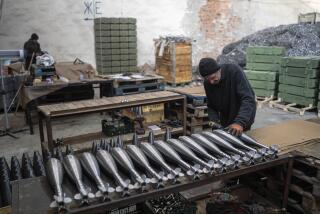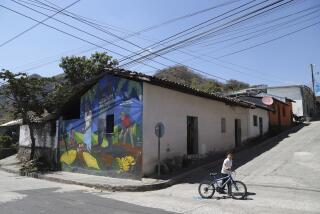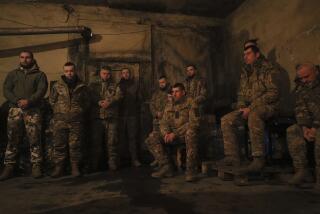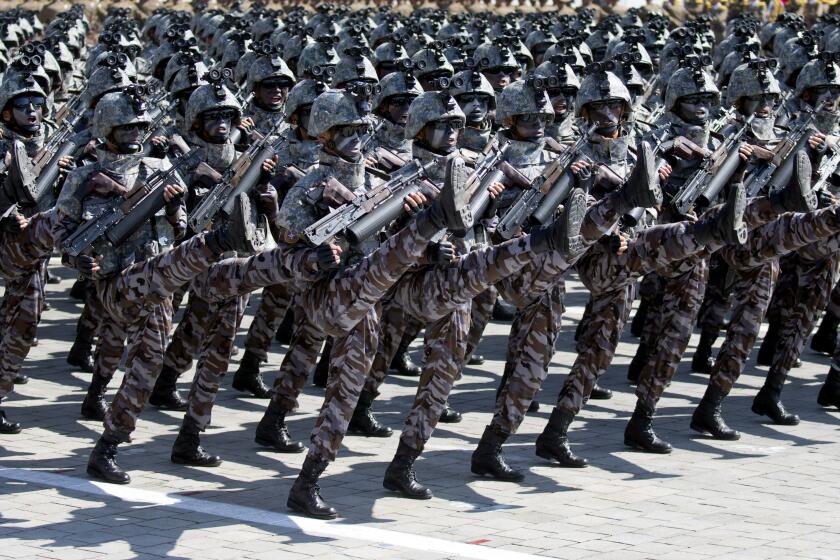Strength of Rebels Grows in Philippines : Successes Prompt Communists to Seek Arms Aid, U.S. Says
WASHINGTON — In the two years since former President Ferdinand E. Marcos fell from power inthe Philippines, the Communist insurgency there has gradually expanded and now controls or has significant political influence over more than one-third of the countryside, U.S. officials say.
U.S. analysts who follow the Philippine Communist movement and its military arm, the New People’s Army, say that largely because of this continued growth, the insurgents have made a strategic decision over the last year to seek arms from abroad. So far, U.S. officials believe, these efforts have failed.
“They’re looking for a steady, reliable supplier,” one U.S. analyst said. “They’re saying, ‘We’ve reached a stage in our revolution where we can’t steal enough arms. We’re getting so many recruits that we can’t supply them all.’ ”
Better Than Marcos Era
Despite their concern about the spread of the insurgency, U.S. officials believe the situation under President Corazon Aquino is better than it might have been had Marcos remained in office. Under goading from the Reagan Administration, Marcos left the Philippines for exile in Honolulu on Feb. 25, 1986.
“What worries me is the growth of the political substructure of the New People’s Army,” one Pentagon official said. “It’s not catastrophic, but it’s disquieting. On the other side of the coin, think how bad it would be if Ferdinand Marcos were still sitting in Malacanang (Palace) with his crazy wife, Imelda.”
U.S. officials believe the most rapid growth of the insurgent movement came during Marcos’ final years in office.
Estimates about the growth and the changing tactics of the NPA were supplied in interviews with U.S. officials who spoke on condition that they not be identified by name.
Future of Two Bases
The United States is just starting negotiations with the Aquino government over the future of Clark Air Base and Subic Bay Naval Base. For years, U.S. officials have argued that these two U.S. bases in the Philippines are crucial to preserving the American military presence in the Pacific.
Although the current bases agreement does not expire until 1991, the two governments are supposed to review the arrangements for them this year.
Last October, three Americans, two of them in active service and one retired, were shot to death in coordinated ambushes outside Clark Air Base. U.S. analysts now believe the ambushes--the first time Americans in the Philippines have been intentionally targeted for attack--reflected a broad change in strategy by the Philippine Communist Party over the last year or so.
“They’re shifting away from the old Maoist approach,” one State Department official said, referring to the strategy by Chinese leader Mao Tse-tung of relying on widespread political support from the peasantry to bring about a revolution. “Now, they’re trying the (Nicaraguan) Sandinista route, or maybe the analogy of (the rebels in) El Salvador would be better. They’re trying to destabilize.”
As part of this change in strategy, U.S. officials have concluded, the insurgents have been actively looking for arms and other help from Communist governments abroad over the last year.
Like Communist insurgent movements in other Asian countries, the Communist Party of the Philippines received support from China in the late 1960s. Throughout most of the 1970s and early 1980s, U.S. officials say, the insurgency operated without significant outside support and relied largely on weapons it could obtain inside the Philippines.
“Until the past year and a half, they didn’t want outside help,” said one U.S. official. “Now they’re out there hustling. They’re at a stage where an outside supplier would be helpful.
“Our early speculation was that Vietnam would play this role,” this official said, since both the Vietnamese and the Philippine insurgents have captured U.S. military equipment. But he said that Vietnam has not supplied arms, perhaps because of the Soviet Union’s restraining influence.
Soviets Not Interested
This analyst and others agreed that, at least for now, the Soviet Union has no interest in supplying arms to the New People’s Army, because that would seriously affect relations with the United States and bring no great benefits.
“Right now, the Soviets see that the Communists are gradually and slowly winning in the Philippines, so why mess it up?” said a high-ranking U.S. official. “They calculate that nationalism is growing so rapidly that within the next decade or so, the United States will be asked to leave. Over the next 15 years or so, we may be out of there.”
There were reports last year that the insurgents might be obtaining arms from North Korea, but U.S. officials said there is no evidence any North Korean arms have actually reached the Philippines. Also, one U.S. official said, North Korea tends to sell arms for money rather than giving them away, and the Philippine Communists are looking for someone to “subsidize their revolution.”
U.S. officials have concluded that the Philippine Communists are relying on money raised in Western Europe, Japan and the United States to help subsidize their operations while they locate an outside arms supplier.
“They’re disappointed,” said one U.S. official. “They argued with one another for years over whether they should ask for outside support. And now, after all their agonizing, they’re asking and nobody wants to give.”
Arms from Abroad ‘Coming’
But another American official had a more pessimistic assessment. Although the NPA has not yet succeeded in getting arms from abroad, he said, they eventually will. “It’s coming,” he predicted.
Over the last few years, officials in both Washington and Manila have used figures of approximately 20% in estimating the extent of Communist strength in the Philippines. The figure represents an estimate of the number of barangays , or political jurisdictions, where Communist forces have established political control or influence.
A year ago, for example, Assistant Defense Secretary Richard L. Armitage told the House Foreign Affairs Subcommittee on Asia and the Pacific that the insurgency had established a “presence” or “influence” in about 20% of rural areas in the Philippines.
But in a recent interview, one senior government analyst said he now calculates that the number of barangays under Communist control or influence in rural areas is “34% or 35%, and this is a conservative estimate. . . . If you exclude Manila and the cities and take just the countryside, it’s more than a third.”
An analyst at another agency, while cautioning that such estimates are inexact, said he would now put the figure at “30% to 40%.”
Growth of Political Influence
“There’s a clear consensus that the political influence of the Communist Party of the Philippines has grown over the past two years,” said Richard J. Kessler, a scholar at American University in Washington who has written a book about the Philippine insurgency. “It’s an extension of a trend that goes back to 1968. What’s different is that when Aquino came to power, the expectation was that the insurgency might decline a little bit.”
The Philippine armed forces have 155,000 troops. U.S. estimates of the military strength of the NPA vary, depending on the extent to which unarmed or part-time fighters are included in the figures.
“If I had to guess on what the total number is, I’d say about 26,000, about half of whom are armed,” one U.S. military analyst said. “There’s another figure that goes around, which says about 18,000 members, with a higher percentage that are armed. But when you boil all these figures down, you get something like 13,000 or 14,000 people running around with reasonable (actual) guns.”
Another U.S. official at a different agency said he estimates that the NPA has 15,000 to 18,000 armed, full-time soldiers. All the U.S. officials cautioned that these estimates of the NPA strength are not exact and are based largely on information supplied by Philippine military and intelligence officials.
“Philippine intelligence is not the most impressive there has ever been,” said one U.S. official. “What there was under Marcos was absolutely decimated after Cory (Aquino) came to power, because these were after all the people in charge of keeping the opposition down, and not in very nice ways. So . . . it’s a real problem.”
Leadership Changes
Kessler, the American University scholar, said that within the past year there have been changes in the leadership of the Philippine Communist Party and a renewed emphasis on “armed struggle” rather than on winning the political support of Philippine peasants.
The search for arms abroad, Kessler said, can be viewed as a consequence of the continuing growth of the insurgency.
“The Philippines is an island nation, and (the insurgents) are dependent for their food and financial support on the peasants they are trying to convert to their insurrection,” he explained. “The more they tax the peasants, the more they harm their political base. They have reached the Malthusian limits of their ability to expand without more military supplies and financial support from abroad.”
More to Read
Sign up for Essential California
The most important California stories and recommendations in your inbox every morning.
You may occasionally receive promotional content from the Los Angeles Times.










